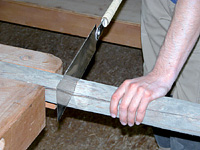Apart from woodworking tools, our product range also comprises garden tools, therefore today we would like to provide you with some gardening tips.
Our tip today: How to set up a raised bed.
You have grown some delicious fresh salad in your vegetable garden and the snails and slugs have grazed down all of it? There are many ways of getting rid of the snails and slugs, however most of them only work up to a point.
Therefore we would like to show you how a raised bed can help you protect your plants from snails and slugs.
Subconstruction

First you need the timbers from the DIY store which are about 50 mm in diameter. Wood types that decompose quickly and are affordable at the same time, such as spruce wood or Douglas fir, are ideal. You can also use treated poles or rods. We do not recommend squared beechwood timbers or remainders of your apple trees, because these wood types were in contact with soil and will decompose within a few months' time.

You need four rods with a length of about 900 mm and a pointed tip at one end. You can easily make a pointed tip by cutting the tip diagonally with an axe or a hatchet. We recommend to put a board under the rod in order to prevent cutting into the ground with the cutting edge.

For cutting the rods, you can use one of our coarse Japanese saws, for example the Silky Tsubasa 285. If you prefer European saws, you can use a regular handsaw.
The total height of the bed in this example is 950 mm, but of course you can adjust the bed according to your individual needs or your own height.
These rods are put into the ground about 10 cm from the corners of the foundation slab. To make sure that the rods with their length of 900 mm reach a total height of 950 mm, the rods have to be put about 20 cm into the ground. We recommend to use a sledgehammer. If you have stony ground, it's better to prepare the ground with a pile-driver.
Now, we are going to build the box

We need spruce wood timbers or you can use multiplex.
Concerning the size of the box, it's up to you to decide which size you need. In this example, we build a box with a length of 1.5 metres and a width of 0.5 metres. The height of the box should be about 25 cm.
We start with the foundation slab of weatherproof glued spruce wood timbers. You can also use multiplex, because it decomposes more slowly than medium-density fibreboard (MDF) or chipboard, and it does not soak itself full of water. In our example, this foundation slab has a length of 1500 mm and a width of 500 mm.

First we need a small solid plastic flowerpot. Cut a hole into the foundation slab nearby the corner using a keyhole saw. The hole should match the diameter of the flowerpot without its edge. If you do not have a keyhole saw, you can simply drill holes along the edge and touch up with a rasp.

Small squared timbers (25/25 mm) are screwed onto the foundation slab from below, flush with the outside edge (see image below). These timbers reinforce the sides. The perfect cordless combination drill for this work can be found at our article number 704524.
For the screws, we recommend to use stainless steel screws. They are more expensive than normal screws, because they do not get rusty. If you intend to keep your new raised bed for a longer time, it's worth using them. If you don't mind the spots of rust on the screws, and your raised bed is not supposed to last forever, you can of course also use normal screws. The long side timbers, which have been cut before according to the length of the foundation slab, are now screwed to the front end of the foundation slab through the prepared squared timber.
To enhance the stability of the corners, you can attach another squared timber to these side boards.


Next step is to measure the width and cut the two broadside timbers. Screw them to the foundation slab.
Now, put the upper part on the four basic poles. Check the position with a spirit level.

It's very easy to correct the position, if necessary: If a pole is too high, just put it deeper into the ground. We need a slight slope towards the drain – simply adjust the poles according to your needs. Before we assemble our raised bed, we put the 4 flowerpots upside down on the poles. Make sure that there is a constant space towards the poles. The flowerpots are attached with a drawing pin. This is our snail & slug protection.
Assembly of the parts

Now you can screw the box from inside on the poles using 4 long screws. It is important to perform a pre-drill through the foundation slab and the flowerpots, otherwise the flowerpot will burst when you screw it.

For the next step you attach the foil. We recommend to use a thick, waterproof foil, for example insulating foil. The inside of the box is lined with the foil in order to protect the slab material or wood from decomposition. Do not use pins or staples, simply attach the foil with soil, otherwise water might seep into the foundation slab. The foil sticks out at the edges, turn it down and pin it to the outside of the box using a drawing pin. Then open the hole you have cut before and that is now covered using a knife and put the flowerpot into the hole. If you wish, you can also paste it with silicone. Now the drain is finished as well.
